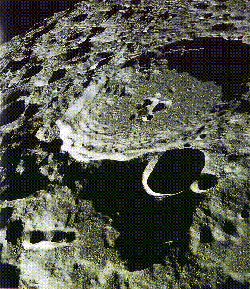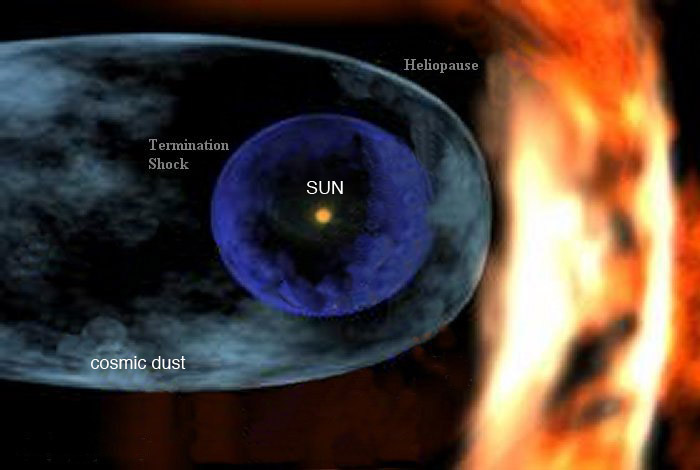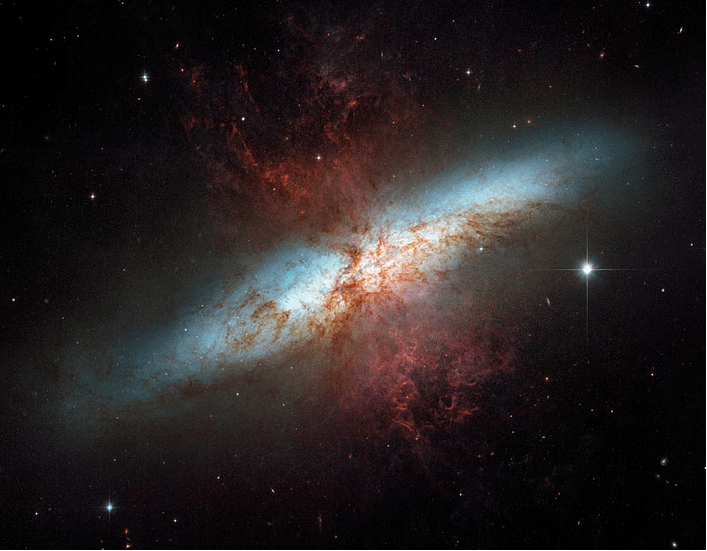While Dr. Paul LaViolette’s research started out as doom & gloom predictions of doomsday cataclysm, various world religions, mystery schools, spiritual channels, extraterrestrial contact, and the traditions of indigenous peoples all point to an end time of ascension, global transformation, and humanity’s rebirth into a higher plane of existence.
Even fringe science is beginning to explain the idea of DNA modification due to sun activity and cosmic radiation. What was once purely accepted as New Age mumbo jumbo is now being actively studied and debated by scientists.
Here are a few more posts worth checking out on the subject:
Galactic Wave: Frequency Shift into September 2015
Solar Activity, DNA Modification, and Consciousness
Scientists: Our DNA is Mutating As We Speak!
Max Igan: Frequency Shift, Reality Reset
The Photon Belt: Raising Earth’s Vibration
Astronomers Try To Explain Mysterious ‘Photon Belt’
Has Doomsday Begun Already?
Reposted from: ViewZone.com | by Gary Vey, 2011
 Although he does not inject himself in to the 2012 controversy, Dr. Paul LaViolette has developed a theory that seems to explain many aspects of the “doomsday” scenario. These ideas were once considered “out there” by many scientists, mainly because they portrayed a world view that was full of apparent chaos and destruction. But in the last decade, his work has been validated — often by his former critics — and scientists are now realizing that chaos and destruction are endemic in the universe [7].
Although he does not inject himself in to the 2012 controversy, Dr. Paul LaViolette has developed a theory that seems to explain many aspects of the “doomsday” scenario. These ideas were once considered “out there” by many scientists, mainly because they portrayed a world view that was full of apparent chaos and destruction. But in the last decade, his work has been validated — often by his former critics — and scientists are now realizing that chaos and destruction are endemic in the universe [7].
We’ve written about Dr. LaViolette before. Rather than sending readers to another page, we’ll recap some of our highlights here in this article. We’ll focus mainly on how this new understanding of our universe can literally impact our Sun, and in turn, our planet.
Here’s the story:
Glazed donuts on the Moon
 Let’s begin back in the 1960s with the Apollo 11 manned landing on the moon. On one of their EVA’s (extra-vehicular activities), the astronauts photographed and took samples from some small craters, about 20cm to 1.5 meters across. When they examined the floors of these craters they noticed what looked like glazed donuts. These were actually chunks of moon dirt that were coated by glass.
Let’s begin back in the 1960s with the Apollo 11 manned landing on the moon. On one of their EVA’s (extra-vehicular activities), the astronauts photographed and took samples from some small craters, about 20cm to 1.5 meters across. When they examined the floors of these craters they noticed what looked like glazed donuts. These were actually chunks of moon dirt that were coated by glass.
The glazed areas are clearly concentrated toward the top surfaces of protuberances, although they exist also on some sides. Points and edges appear to be strongly favored for the glazing process. In some cases, droplets appear to have run down an inclined surface for a few millimeters and congealed there. [1]
Hardly anyone in the general public was made aware of this discovery and, even if they were, thay could hardly have realized the significance.
But in 1969, an article in Science by T. Gold [1] proposed a theory of how they were made. Glass, as we know, is made from melting sand. It occurs naturally near sources of high temperature, such as volcanos and meteor impacts. The atom bomb tests in New Mexico’s White Sands area produced a small “lake” of glass at ground zero. So it was never a question about the lunar glass also having been created by something very hot.
The fact that the glaze was confined to small patches, 0.5 to 10mm, suggested to scientists that the surface had been zapped rather than slow-cooked. And the likely source of this zap was our Sun. Gold estimated that the solar luminosity would have had to increase by 100 times what it is normally, for a duration of from 10 to 100 seconds.
Also, because of the lack of debris or dirt covering this glass, it must have occurred within the last 30,000 years. This made Gold propose that the Sun — our Sun — does this every 10,000 years or more. He suggested that future research should look for a “trigger” event — possibly a large comet or asteroid impacting the surface of the Sun. He estimated this would only have to be 100 km and weigh 3 x 1021 grams.
 Decades passed and this theory didn’t receive much attention. Then, as it often does, the theory got a fresh look by a genius, Dr. Paul LaViolette. He was not satisfied with the source of the glass being caused by a solar blast, mainly because the output would have had to be on the scale of a nova, not just a flare. He envisioned another possibility.
Decades passed and this theory didn’t receive much attention. Then, as it often does, the theory got a fresh look by a genius, Dr. Paul LaViolette. He was not satisfied with the source of the glass being caused by a solar blast, mainly because the output would have had to be on the scale of a nova, not just a flare. He envisioned another possibility.
LaViolette envisioned a large solar flare or coronal mass ejection (CME) that would become magnetically entrapped in the Earth’s magnetosphere [2]. The magnetosphere would then hold on to this fireball of radiation like a magnetic thermos bottle, allowing the Moon and Earth to be exposed for a duration of time long enough to really “flash bake” their surfaces.
Critics quickly denounced Gold’s propositions citing evidence of “cosmic dust” and rare elements in the lunar glass and concluding that the heat source was from a meteor impact. [3]
But LaViolette proposed that this cosmic dust was likely present on the surface of the Moon during the time it was melted into the glass. In fact, he proposed that the entire solar system was full of this cosmic dust at the time of this solar eruption. He was vindicated when polar ice cores showed unusual cosmic dust deposits at strata marking the end of the last ice age [4]. This time period, about 12,950 BCE [10], approximates the current age of the Moon glass and the intense heat that must have produced it. So where did all this cosmic dust come from?

Like Earth, our entire solar system has its own atmosphere, called the heliosphere. This “bubble” surrounds the Sun and planets as it travels through galactic space. Like our earth’s magnetosphere, the movement of the heliosphere creates a rounded “head” and a narrowing “tail” (called the heliopause). Actually, it’s more egg shaped (see above). Until recently, astronomers believed that our solar system was a region relatively free from cosmic dust. The cosmic dust and frozen material of space were kept outside this protective bubble.
This was confirmed when the IRAS and Ulysses spacecrafts showed infrared images of the solar system, surrounded by whispy clouds of cosmic dust that increase in density just beyond Saturn.
So if the cosmic dust is surrounding the heliopause, what would make it suddenly enter the heliosphere and how would this coincide with huge solar flares? LaViolette envisioned something disrupting the heliosphere from the outside, impacting it and drawing cosmic dust inside with it and energizing the Sun. The energy of such an impact would be immense. The most logical place to look for such enormous energy was the Milky Way Galaxy.
The Smoking Gun
 Examining the shape of the cosmic dust clouds, the IRAS satellite team reported that the cloud was tilted relative to the solar system’s ecliptic — the narrow plane containing our planets. LaViolette realized that this odd alignment tracked back to the Galactic center. This was quickly verified by NASA’s Ulysses spacecraft and New Zealand’s AMOR space radar observatory. Whatever caused the last ice age to end, the Sun to flare up and caused the glass to form on the Moon, came from the center of the Milky Way Galaxy. The plot was getting more interesting.
Examining the shape of the cosmic dust clouds, the IRAS satellite team reported that the cloud was tilted relative to the solar system’s ecliptic — the narrow plane containing our planets. LaViolette realized that this odd alignment tracked back to the Galactic center. This was quickly verified by NASA’s Ulysses spacecraft and New Zealand’s AMOR space radar observatory. Whatever caused the last ice age to end, the Sun to flare up and caused the glass to form on the Moon, came from the center of the Milky Way Galaxy. The plot was getting more interesting.
Astronomers have known about intense radiation from space since the 1970s. Multiple bursts of powerful gamma rays were routinely detected and believed to originate from stars in the Milky Way. Assuming this energy originated locally, astronomers concluded this type of gamma ray burst was insignificant and harmless. Then, in December 1997, they had the technology and good luck to catch a strong gamma ray burst and track it. The source was not inside the Milky Way Galaxy. It was from a distant galaxy billions of light years away.
 A review of other bursts showed that their assumptions had been wrong. All of the gamma ray bursts they were observing were from other galaxies far, far away. The amount of energy coming from objects so distant was a real shock. No one had ever imagined such powerful bursts could be generated by galactic centers. The thought of a burst coming from our own Milky Way galactic center was abysmal. A burst of the same intensity as the 1997 event, originating from inside the Milky Way, would deliver 100,000 time the lethal dose of radiation, killing every life form that was exposed. Could that really happen to us?
A review of other bursts showed that their assumptions had been wrong. All of the gamma ray bursts they were observing were from other galaxies far, far away. The amount of energy coming from objects so distant was a real shock. No one had ever imagined such powerful bursts could be generated by galactic centers. The thought of a burst coming from our own Milky Way galactic center was abysmal. A burst of the same intensity as the 1997 event, originating from inside the Milky Way, would deliver 100,000 time the lethal dose of radiation, killing every life form that was exposed. Could that really happen to us?
This question was answered on August 27th, 1998 when an unusual 5 minute gamma ray pulse was located just 20,000 light years away in the constellation of Aquila. This may sound like a huge distance, but to astronomers this is just “next door.” The Milky Way Galaxy, for example, is just 100,000 light years from end to end and Earth is just 23,000 light years from our Galaxy’s center.
The 1998 event was close enough and strong enough to ionize Earth’s upper atmosphere, damage a couple of spacecraft and disrupt global communication. Since then astronomers place gamma ray bursts from the Galaxy’s core at the top of the list of things we don’t want to happen.
Before Aquila, scientists just feared exploding stars — novas and supernovas. Now things are different. It’s like living in a ghetto and fearing drive-by shootings and random bullets. Then one day you learn that there’s a nuclear bomb down the street, waiting to explode.
Ancient warnings from past experience
The Hopi are an Native American Indian tribe who have not sold out or assimilated in our modern culture. They view themselves as the “keepers of the truth” about our purpose and place in the universe. Anyone who has ever visited their small reservation in Arizona has experienced how private they are — forbidding photographs or copies of their art and culture. For centuries they have kept an oral tradition which describes human history in terms of “worlds” — successive eras which end in natural disasters, culling humanity and initiating a rebirth of civilization.
According to their teachings, the Hopi describe three prior worlds. We are currently in the fourth world, about to enter the fifth.
The Hopi elder, White Feather, of the spiritually important Bear Clan, describes nine different signs signaling the end of this Fourth World. Some believe all but the last sign has already happened. The final warning is as follows:
“And this is the Ninth and Last Sign: You will hear of a dwelling-place in the heavens, above the earth, that shall fall with a great crash. It will appear as a blue star. Very soon after this, the ceremonies of my people will cease.” –www.burlingtonnews.net/hopiprophecy.html
In Dr. LaViolette’s scenario of the Galactic SuperWave, the explosion emanating from Galactic nuclear bulge, would make its initial appearance as a flood of cosmic ray electrons that would illuminate the dust clouds normally obscuring the Galactic center. As seen in many other galaxies, this would appear as a glowing blue light. The appearance of the “blue star” would signal the arrival of a shock wave which would counter the solar wind and bring the surrounding cloud of cosmic dust inside our solar system. This would initially energize the Sun, causing it to throw off flares and coronal mass ejections which would undoubtedly impact Earth (and the Moon). But eventually the cosmic dust would obscure the Sun’s light, reminiscent of other predictions:
“When he opened the sixth seal, I looked, and behold, there was a great earthquake, and the sun became black as sackcloth, the full moon became like blood… — Revelations 6:12
This cloud of cosmic dust would plunge the Earth into a cold climate fairly quickly. What forms of life that did not die from radiation and heat would surely struggle to keep going in a dark and cold world.
LaViolette… in his own words(2006) Dr. Paul LaViolette: A conservative guess would be that there is a 90% chance that a superwave will arrive in the next four centuries. I cannot rule out the possibility that one might arrive around the time of the Mayan calendar end date of 2012, as some proclaim. And others have felt that a catastrophic event might occur even sooner. It is just that investigations of the Galactic center mass (Sagittarius A) show that the core continues in its present quiescent state. Whether this present tranquil state will without warning come to a sudden end, I cannot say. All we can do at present is talk of future probabilities by looking at what has happened in the past. A study of the past shows that we are overdue for a small event, one similar to the bursts that resulted in the 14 gas expulsions which issued from the Galactic center over the past 5300 years. It has been 700 years since the last event and on only two occasions was there a time lapse between events longer than this. Whether the next event will be a small superwave event (Magnitude 1 event) or a much larger climatically significant event (Magnitude 3 or 4 event) is difficult to say. In referring to past events, it helps to use a magnitude scale as is used in describing the strengths of earthquakes and tornadoes. However, since we do not have real time data, such a scale is understandably very qualitative. We might rank the severity of Galactic superwaves as given below. Galactic Superwave Event Ranking Magnitude 1: A superwave cosmic ray burst that is not detectable above cosmic background levels but which carries a gamma ray burst and gravity wave pulse at its forefront. This would likely produce seismic and EMP effects much stronger than the December 2004 earthquake and gamma ray burst. Magnitude 2: A short duration superwave cosmic ray burst that produces a moderate increase above cosmic background levels and a minor climatic disturbance. This would be similar to the events that occurred around 5300 years ago which produced approximately a 50% increase in the cosmic ray background over a period of about one to two hundred years. This resulted in some temporary climatic change such as blizzards, but was not severe enough to perturb climate from its present interglacial phase. Magnitude 3: A long duration superwave cosmic ray burst that produces a major increase in the cosmic ray background level, doubling the background level, lasting several hundred to a thousand years, and injecting interstellar dust in sufficient quantities to destabilize climate initiating a period of glacial growth. Examples would be the events that initiated glacial stage 5-d about 110,000 years ago or stage 4 about 70,000 years ago. Magnitude 4: A much longer duration superwave cosmic ray burst capable of increasing the cosmic ray levels 2 to 4 fold above the background level and lasting several thousand years, with dust injection into the solar system maintained long enough to activate the Sun into a state of excessive flare activity. Such an event would induce climatic effects more extreme than a Magnitude 3 superwave, sufficient to initiate a global warming period that would terminate an ice age or induce an interstadial. Examples would be the superwave events that ended the Illinoisan glaciation (stage 6) about 130,000 – 140,000 years ago or ended the Wisconsin ice age about 16,000 – 10,000 years ago, the more recent precipitating the Pleistocene extinction. Another event around 34,000 – 37,000 years ago [11] occurred around the time of the demise of Neanderthal Man. |
Full article: https://deusnexus.wordpress.com/2015/07/29/galactic-super-wave-theory/

[…] ++ Dr. Paul LaViolette’s Galactic SuperWave Theory […]